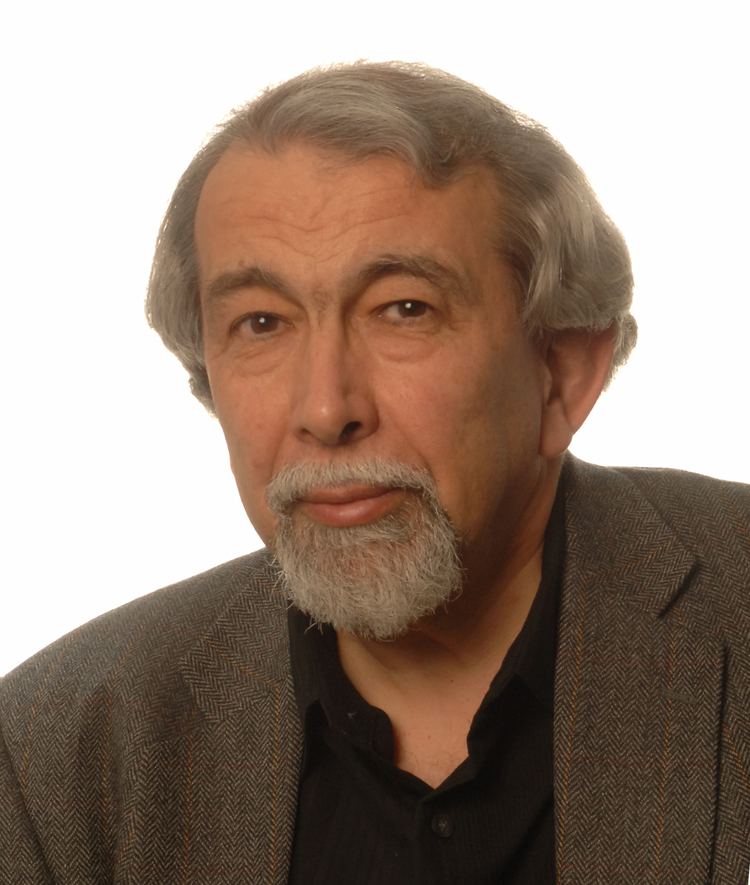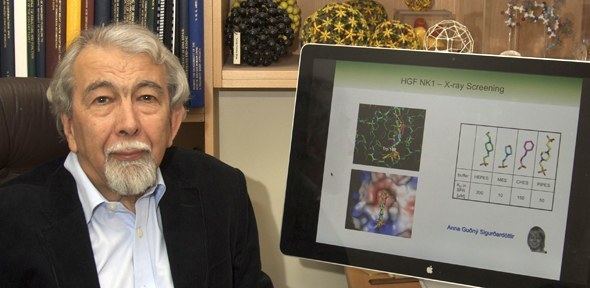Name Tom Blundell Doctoral advisor HM Powell, FRS | ||
 | ||
Institutions University of CambridgeUniversity of OxfordUniversity of SussexBirkbeck, University of LondonBBSRCAFRCAstex Thesis The determination by X-ray diffraction methods of the crystal and molecular structures of some coordination compounds (1969) Doctoral students Tim HubbardJohn OveringtonLaurence PearlAndrej Sali Known for Insulin structureDrug design Education | ||
Darwin day lecture 2013 the emergence of drug resistance sir tom blundell richard dawkins
Sir Thomas Leon "Tom" Blundell, FRS, FMedSci (born 7 July 1942) is a British biochemist, structural biologist, and science administrator. He was a member of the team of Dorothy Hodgkin that solved in 1969 the first structure of a protein hormone, insulin. Blundell has made contributions to the structural biology of polypeptide hormones, growth factors, receptor activation, signal transduction, and DNA double-strand break repair, subjects important in cancer, tuberculosis, and familial diseases. He has developed software for protein modelling and understanding the effects of mutations on protein function, leading to new approaches to structure-guided and fragment-based drug discovery. In 1999 he co-founded the oncology company Astex Therapeutics, which has moved ten drugs into clinical trials. Blundell has played central roles in restructuring British research councils and, as President of the UK Science Council, in developing professionalism in the practice of science.
Contents
- Darwin day lecture 2013 the emergence of drug resistance sir tom blundell richard dawkins
- Professor sir tom blundell biology changing the world interview
- Education
- Career
- Research
- Awards and honours
- References

Professor sir tom blundell biology changing the world interview
Education
Born in Brighton in 1942, Blundell was educated at Steyning Grammar School. He was the first in his family to attend university, winning an Open Scholarship to Oxford. He earned a First Class degree in Natural Sciences in 1964, then moved to research in the Department of Chemical Crystallography, first with HM Powell FRS for his DPhil and later working on insulin with Dorothy Hodgkin.
Career
Blundell's early posts were at the University of Oxford and the University of Sussex. In 1976, Blundell joined the Department of Crystallography at Birkbeck, University of London, becoming head of department in 1978.
In 1991, while continuing academic research, he moved further into science administration and policy, as Director General of the Agricultural and Food Research Council (1991–94) and then the founding Chief Executive of the Biotechnology and Biological Sciences Research Council (BBSRC) (1994–1996). He is a former President of the Biosciences Federation (2004–06). In June 2011 he became President of the Science Council.
In 1995 he became the fifth Sir William Dunn Professor of Biochemistry and head of the Department of Biochemistry at the University of Cambridge; he currently also holds the Chair of the School of Biological Sciences at that university. He is a fellow of Sidney Sussex College. His speciality is molecular biology and his research on identifying the chemical processes of diseases has led to the development of drugs to treat Aids, cancer, cataracts and diabetes. He is the co-founder of two drug discovery companies, Astex Technology Ltd and Biofabrika.
On 15 September 2010, Blundell, along with 54 other public figures, signed an open letter published in The Guardian, stating their opposition to Pope Benedict XVI's state visit to the UK.
Blundell has been active on environmental issues, first as Chair of the Planning Committee of the Oxford City Council (1970–73), during the time when it stopped the building of a motorway through the city centre, pedestrianised much of the historic centre, and made North Oxford a conservation area. From 1998 to 2005 he was Chair of the Royal Commission on Environmental Pollution, when he oversaw the production of key reports such as those on "Energy – the Changing Climate", "Chemicals in Products – Safeguarding the Environment and Human Health", and "Turning the Tide: Addressing the Impact of Fisheries on the Marine Environment". He is a Distinguished Member of the British Humanist Association [7].
Research
Blundell's research interests lie in elucidating the architecture and function of macromolecules and their multi-component assemblies using methods from biochemistry, protein crystallography, and bioinformatics, with the objectives of understanding biological function, of knowledge-based prediction of structure, and of discovering new therapeutics for cancer and tuberculosis. Systems studied include DNA repair, hormones, growth factors and hormone/receptor interactions, cellular signalling, crystallins (lens proteins), renin and HIV protease. He has contributed 235 crystal structures to the worldwide Protein Data Bank (accessed 3/3/16). At least seven of the Molecule-of-the-Month features at the RCSB site of the worldwide Protein Databank have featured molecular structures solved and studied by the Blundell lab, such as the glucagon hormone shown at left in David Goodsell's drawing, nerve growth factor, the RAD51-BRCA2 DNA recombination complex, and the DNA ligase shown at right. His group has written several broadly used bioinformatics programs. He co-authored a textbook on protein crystallography with Louise Johnson, which was translated into French and Russian.
Awards and honours
Blundell was elected a Fellow of the Royal Society (FRS) in 1984. His nomination reads:
Blundell became one of the first fellows of the Academy of Medical Sciences in 1998. He was elected a member of European Molecular Biology Organisation (EMBO) in 1985; Member Academia Europaea in 1993; Founding Member, Academy of Medical Sciences 1999. International recognition has come in his election as a Foreign Member of the Indian National Science Academy (http://www.insaindia.org), the Chilean Academy (http://www.academia-ciencias.cl) and The World Academy of Sciences TWAS (http://twas.org).
Blundell has received numerous awards and medals, including the Alcon Award for Vision Research in 1986; Gold Medal, Institute of Biotechnology in 1987; Krebs Medal FEBS 1987; Ciba Medal, Biochemical Society in 1988; Feldberg Prize in Biology and Medicine in 1988; Gold Medal, Society of Chemical Industry in 1996; First Recipient, Pfizer European Prize for Innovation in 1998 and Bernal Lecture, Royal Society 1998. Most recently he received the 2013 Biochemical Society Award and Cambridge University Science Prize called the Philosophical Society Fellows Prize & Lecture 2014. He has been President, UK Biosciences Federation (2003–2009); President, Biochemical Society (2009–2011); and President, UK Science Council (since 2011) (http://sciencecouncil.org).
Blundell's contributions were recognised by a knighthood in 1997. He has been awarded Honorary Doctorate degrees from 16 universities. An audio account of his life and interests is to be found on the BBC radio programme, Desert Island Discs 2006 (http://www.bbc.co.uk/radio4/features/desert-island-discs/castaway/9016cb56). Tom was a guest on Desert Island Discs.[12]
